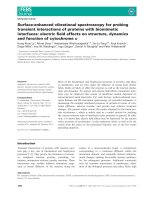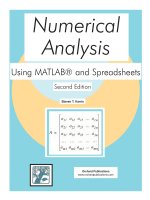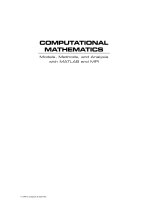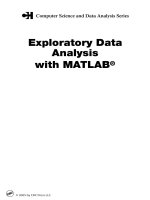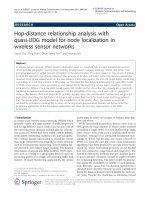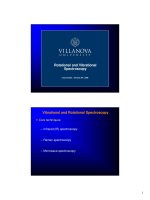Industrial analysis with vibrational spectroscopy
Bạn đang xem bản rút gọn của tài liệu. Xem và tải ngay bản đầy đủ của tài liệu tại đây (20.97 MB, 394 trang )
www.pdfgrip.com
INDUSTRIAL ANALYSIS WITH
VIBRATIONAL SPECTROSCOPY
www.pdfgrip.com
RSC Analytical Spectroscopy Monographs
Series Editor: Neil Barnett, Deakin University, Victoria, Australia
Advisory Panel: F. Adams, Universitaire Instelling Antwerp, Wirijk, Belgium;
R. Browner, Georgia Institute of Technology, Atlanta, Georgia, USA; J . Callis,
Washington University, Seattle, Washington, USA; J. Chalmers, ICI
Technology, UK; J. Monaghan, University of Edinburgh, UK; A. Sanz Medel,
Universidad de Oviedo, Spain; R. Snook, UMIST, Manchester, UK
The series aims to provide a tutorial approach to the use of spectrometric and
spectroscopic measurement techniques in analytical science, providing guidance
and advice to individuals on a day-to-day basis during the course of their work
with the emphasis on important practical aspects of the subject.
Flame Spectrometry in Environmental Chemical Analysis: A Practical Guide, by
Malcolm S . Cresser, Department of Plant and Soil Science, University of Aberdeen, UK
Chemometrics in Analytical Spectroscopy, by Mike J. Adams, School of Applied
Sciences, University of Wolverhampton, UK
Inductively Coupled and Microwave Induced Plasma Sources for Mass Spectrometry,
by E. Hywel Evans, Department of Environmental Sciences, University of Plymouth,
UK,Jeffrey J. Giglio, Theresa M. Castillano, and Joseph A. Caruso, University of
Cincinnati, Ohio, USA
Industrial Analysis with Vibrational Spectroscopy, by John M. Chalmers, ICI
Technology, Research & Technology Centre, Wilton, UK; Geoffrey Dent, Zeneca
Specialties, Blackley, UK
Ionization Methods in Organic Mass Spectrometry, by Alison E. Ashcroft, Micromass
UK Ltd., Altrincham, UK
How to obtain future titles on publication
A standing order plan is available for this series. A standing order will bring delivery of
each new volume immediately upon publication. For further information, please write
to:
Turpin Distribution Services Ltd., Blackhorse Road, Letchworth, Hertfordshire
SG6 1HN, UK. Telephone: + 44 (0) 1462 672555; Fax: + 44 (0) 1462 480947
www.pdfgrip.com
RSC
A N A LYTI CA L
SPECTROSCOPY
MONOGRAPHS
Industrial Analysis with
Vibrational Spectroscopy
John M . Chalmers
ICI Technology, Research & Technology Centre, Wilton, UK
Geoffrey Dent
Zeneca Specialties, Blackley, UK
THE ROYAL
SOCIETY OF
CHEMISTRY
information
Services
www.pdfgrip.com
A catalogue record for this book is available from the British Library.
ISBN 0-85404-565-1
0The Royal Society of Chemistry 1997
All rights reserved.
Apart from any fair dealing for the purposes of research or private study, or criticism or review as
permitted under the terms of the UK Copyright, Designs and Patents Act, 1988, this publication may
not be reproduced, stored or transmitted, in any form or by any means, without the prior permission in
writing of The RoyaI Society of Chemistry, or in the case of reprographic reproduction onIy in
accordance with the terms of the licences issued by the Copyright Licensing Agency in the UK, or in
accordance with the terms of the licences issued by the appropriate Reproduction Rights Organization
outside the UK. Enquiries concerning reproduction outside the terms stated here should be sent to The
Royal Society of Chemistry at the address printed on this page.
Published by The Royal Society of Chemistry,
Thomas Graham House, Science Park, Milton Road, Cambridge CB4 4WF, UK
Typeset by Paston Press Ltd., Loddon, Norfolk
Printed by Athenaeum Press Ltd., Gateshead, Tyne and Wear, UK
www.pdfgrip.com
Preface
Infrared spectroscopy has been a mainstay of laboratory industrial analysis,
materials characterisations, and research support for over forty years; while,
Raman spectroscopy, following a couple of inroads, is now truly establishing its
position as an invaluable, cost-effective resource, alongside its vibrational
spectroscopy partner. For us, the many distinctions that once clearly existed
between infrared and Raman applications and their industrial value have, in the
last few years, rapidly become blurred, and the technique pair are now totally
integrated and complementary tools within our work environments. It is for this
reason, and a strong belief that industrial Raman spectroscopy is here to stay in
a big way and will supersede infrared in some areas of application, that we have
in this monograph tried, wherever possible, to integrate and contrast our
discussions of the two vibrational spectroscopy techniques.
We are aware that to the purist or well-informed expert some of our
descriptions and discussions may seem a little too superficial, but, in trying to
present a broad relevant perspective, this has been deliberate. At the practical,
implementation level, the industrial laboratory-based vibrational spectroscopist
needs a sound grasp of the principles and differences underlying the techniques,
together with a working knowledge of the instrumentation and equipment being
used and its limitations. This we have tried to impart, using for the latter
technical information that is essentially freely available through published
articles and manufacturers’ literature, while, through references and bibliographies, pointing the reader to sources of more theoretical treatments of
vibrational spectroscopy. One of our main aims has been to illustrate our
discussions with examples of practical ‘real-world’ applications, emphasising,
where our experience allowed, as much ‘what can go wrong’ as ‘how to get it
right’. This experience, and the personal comments throughout the text, are the
result of two long careers spent thus far in industrial vibrational spectroscopy
laboratories, in which one of the things we have learned is that time spent
experimenting with and comparing different sampling techniques and differing
sample forms, even the most simple, will be hugely rewarded. Spectra produced
are the consequence of sample presentation and morphology, and if the
practical spectroscopist is not aware of the anomalies and artefacts that they
may contain, then he/she is treading a very dangerous path. Interpreting
artefacts can be extremely costly not only to one’s employers, but also to one’s
www.pdfgrip.com
vi
Preface
career! In discussing interpretation we have been pragmatic, since industrial
spectroscopists are primarily concerned with problem-solving and support
research, rather than developing full spectral band-assignments. For this
reason, we have also regularly emphasised the importance of complementing
vibrational spectroscopy evidence with that from other analytical techniques.
To work in a ‘tube’ is also extremely hazardous! Quantification, to many
applications as important as qualitative studies, has been developed from the
simple single analyte measurement through to multivariate analysis approaches.
We are acutely aware (and frustrated) that, of necessity in a monograph of
this size, ‘much is missing’, in particular we have avoided other than a passing
mention of Near-Infrared Analysis (NIRA) and process in-line and environmental monitoring applications, all of which are extremely important industrially, but are likely to be the subjects of future monographs in this series. It has
been our intention to provide a monograph that would be an informative and
useful working tool to practical spectroscopists, in both industry and universities.
www.pdfgrip.com
Contents
Chapter 1 Introduction, Basic Theory, and Principles
1 Introduction
2 Simple Theory
3 Molecular Vibrations
4 Selection Rules
5 Practical Interpretation of Spectra
Sample Presentation Factors Affecting Interpretation
Instrumentation Features
Beware the Computer - Spectrum Manipulation
Step-by-step Approach to Interpretation
6 Computer-aided Spectrum Interpretation
Library Search Systems
Structural Determination Aids
Spectra Formats for Transfer and Exchange of Data
The Internet
7 Instrument Performance Checks
The ICI/Zeneca Polystyrene ‘Round-robin’ Trial
Commercially Available Traceable Standards for Infrared
Raman Spectroscopy Calibration Standards
8 Quantification
9 Closing Remarks
10 Bibliography
1
1
3
3
5
9
12
15
17
21
25
25
25
26
26
27
27
32
32
33
33
33
Chapter 2 Sample Types and Analyses
37
1 Introduction
2 Structural Information
Polymorphism
Taut omerism
Hydrogen Bonding
Racemates
3 Formulations
4 Polymers
5 Fibres
37
38
38
41
42
45
47
47
47
www.pdfgrip.com
...
Contents
Vlll
6 Surface Analysis
7 Inorganics, Metal Co-ordination Compounds, and
Semi-conductors
8 Liquids
9 Gases and Vapours
10 Closing Remarks
Chapter 3 Instrumentation
1
2
3
4
Introduction
Infrared Spectrometers
Raman Spectrometers
Sources
Infrared Sources
Raman Sources
5 Detectors
Infrared Detectors
Raman Detectors
6 Filters, Prisms, Gratings, Monochromators, and
Interferometers
Filters
Prisms and Gratings
Monochromators (Dispersive Spectrometers)
Interferometers
7 Closing Remarks
54
56
59
60
61
62
62
63
63
65
66
66
69
69
79
76
76
78
79
86
117
Chapter 4 Sampling Techniques and Accessories
1 General Introduction
2 Basic Principles of Sample Preparation for Infrared
Spectroscopy
3 Window Materials for Infrared Spectroscopy
4 Preparation and Cleaning of Windows for Infrared
Spectroscopy
5 Transmission Techniques for Infrared Spectroscopy
Capillary Films
Cast Films
Spectrum Quality of Capillary and Cast Films
Films from the Melt
Fixed and Variable Path-length Cells
Powder Sampling Methods
Gases and Vapours
Variable Temperature and Pressure
6 Reflection Techniques for Infrared Spectroscopy
Internal Reflection Spectroscopy (IRS) Techniques
Diffuse Reflectance Infrared Fourier Transform
Spectroscopy (DRIFTS)
www.pdfgrip.com
120
120
121
123
125
125
126
127
128
131
133
141
143
144
145
153
ix
Contents
7
8
9
10
11
Specular Reflectance
Reflection-A bsorption Spectroscopy
Photoacoustic Spectroscopy (PAS)
Emission Spectroscopy
Raman Sample Preparation and Handling
Closing Remarks
Bibliography
Chapter 5 Quantitative Analysis
1 Introduction
2 Infrared Absorption
Beer’s Law
Absorbance Intensity
Measurement of Path-length for Transmission
Measurements
Normali sed Absorbance Intensity
3 Raman Scatter Intensity
4 Quantitative Analysis of Vibrational Spectroscopic Data
Calibration of Quantitative Methods
Band Ratio Measurements
Ratio of Spectra Method
Least-squares Determinations and Multiple Linear
Regression
5 Multicomponent Analyses and Multivariate Techniques
General Introduction to Quantitative Multicomponent
Analysis
The K-matrix and P-matrix Methods
Principal Component Analysis (PCA) and Factor
Analysis (FA)
Principal Component Regression (PCR) and Partial
Least Squares (PLS) Modelling
6 Spectral Enhancement and Band Resolution Techniques
Derivative Spectroscopy
Fourier Domain Processing
Curve-fitting
Maximum Entropy Method (MEM) and Maximum
Likelihood
7 Statistical Expressions
8 Closing Remarks
Chapter 6 Vibrational Spectroscopy - Microsampling and
Microscopy
1 Introduction
2 Micro-sampling by Raman Spectroscopy
www.pdfgrip.com
160
162
165
168
169
174
175
176
176
177
177
181
183
186
188
190
191
192
194
197
20 1
202
203
206
213
219
220
224
228
232
235
239
241
24 1
242
Contents
X
3 Micro-sampling by Infrared Spectroscopy
Micro-sampling of Gases
Micro-sampling of Liquids
Micro-sampling of Solids
4 Vibrational Spectroscopy-Microscopy
Vibrational Spectroscopy-Microscopy Instrumentation
Vibrational Spectroscopy-Microscopy Sample
Presentation Methods
5 Vibrational Spectroscopy-Microscop y Applications
Vibrational Spectroscopy-Microscopy Applications:
Chemical Studies
Vibrational Spectroscopy-Microscopy Applications:
Physical Characterisations
6 Closing Remarks
Chapter 7 Hyphenated Techniques
1 Introduction
2 Gas Chromatography-FTIR (GC-FTIR)
Coupled Systems
Effect of GC Column Selection
Cold Spots
Dedicated GC-FTIR Systems
Comparison of Detector Systems and Their Spectra
3 Liquid and Gel Permeation Chromatography-FTIR
(HPLC-FTIR, GPC-FTIR)
Flow-through Techniques
Deposition Techniques
4 Supercritical Fluid Chromatography-FTIR (SFC-FTIR)
5 Other Hyphenated/Combination Techniques
Thin Layer Chromatography (TLC-FTIR, TLC-Raman)
Evolved Gas Analysis (EGA-FTIR)
Thermogravimetric Analysis (TGA-FTIR)
Differential Scanning Calorimetry (DSC-FTIR,
DSC-FT-Raman)
6 Closing Remarks
Subject Index
244
244
245
245
255
256
269
277
278
304
329
331
33 1
332
333
335
335
335
34 1
351
35 1
353
359
361
36 1
364
365
367
368
371
www.pdfgrip.com
Acknowledgements
We are indebted to our respective employers, ICI Technology and Zeneca
Specialties, for permissions to publish this monograph.
We would also like to thank many colleagues and mentors, both present and
past, with whom we have worked in our respective companies’ vibrational
spectroscopy laboratories. Many have stimulated our interests and discussed
and argued with us about industrial vibrational spectroscopy techniques and
their applications, over many years. In particular, we would like to acknowledge
Neil Everall, for his patience and advice through many discussions and
interruptions. We would also like to thank many associates in the instrument
and accessory companies, all of whom, when asked, have been generous in their
offerings of diagrams and technical information, particularly David Coombs
(Graseby Specac) and Marita Sweeney (Spectra-Tech).
Clearly, in our attempts to illustrate as wide an area of industrial applications
as feasible in a book of this size, we have included some application examples
which we have ‘borrowed’ and we thank the providers. In addition, there are
others for which we have very limited personal practical experience. We hope
for the latter that we have selected wisely, in keeping with the quotation
following:
About the most originality that any writer can hope to achieve honestly
is to steal with goodjudgment.
Josh Billings
www.pdfgrip.com
www.pdfgrip.com
CHAPTER 1
Introduction, Basic Theory, and
Principles
1 Introduction
The vibrational spectroscopies, infrared and Raman, are techniques that are
widely used in industry. They provide information on the chemical structures
and physical characteristics of materials; they are used for the identification of
substances by ‘fingerprinting’; and they are used to provide quantitative or
semi-quantitative information on products and processes. Samples may be
examined in bulk or microscopic amounts over a wide range of temperatures,
from very hot to very cold, in a whole range of physical states, e.g. as vapours,
liquids, latexes, powders, films, and fibres, or as a surface or an embedded
layer. The techniques have a very broad range of applications and provide
solutions to a host of interesting, commercially important, and challenging
analytical problems. They are used to analyse and characterise feedstocks,
catalysts, by-products, end and formulated products, processed and fabricated
materials, and in deformulation (reverse engineering) studies of competitors’
products.
In the Research Laboratory, vibrational spectroscopies are frequently used
for reaction following, or for giving chemical group information on new
compounds. They are amongst the few techniques which can assist molecular
interaction studies such as hydrogen bonding, and provide molecular orientation information for surface studies. In the Process Development and Works
environments, quantitative information for process monitoring and product
quality assurance/control (QA/QC) can be very important; an increasing
development here is in the use of multicomponent analysis of infrared and
Raman data, employing regressional analysis and other chemometric treatments. Simple ‘fingerprinting’ techniques are used extensively in identifying raw
materials, but more often in characterising formulated products. The latter is an
important QA technique, and a common first step in dealing with customer
problems in support of Technical Service/Marketing Departments. Industrially,
Raman has been a much less used technique than infrared spectroscopy, largely
due to problems associated with colour and fluorescence. However, with recent
advances in instrument technology, coupled with the ability to use Raman to
1
www.pdfgrip.com
Chapter I
2
effectively examine aqueous solutions and samples inside glass containers, there
is a rapid increase in industrial applications of the Raman technique.
Infrared (IR) spectroscopy and Raman spectroscopy are both vibrational
techniques; the former is concerned essentially with the absorption of radiation,
the latter with scattered radiation. The two techniques are complementary.
Their spectra may be considered as being recorded essentially over the same
spectral range; both give rise to bands in similar positions originating from the
same chemical group. Generally, vibrations which have large changes of dipole
moment, e.g. the stretching of a carbonyl group (vC=O), gives rise to strong
infrared bands and much weaker Raman bands, whilst for vibrations from
groups which cause large changes in polarisability, e.g. the symmetrical
unsaturated group (vC=C), the reverse is true, i.e. the band within the Raman
spectrum will be relatively much stronger, and weak or even absent in its
infrared counterpart. (Here, v is the notation used to describe a fundamental
stretching vibration frequency.)
Although the theory and basic principles of each technique and interpretation of their spectra have similarities, important differences need to be
highlighted. However, it is not our intention in this chapter to give an indepth theoretical approach to the interpretation of vibrational spectra. Basic
principles will be set out to enable an initial assessment of spectra and to help
avoid a few pitfalls. In infrared spectroscopy, a spectrum is recorded of the
absorption of energy from photons by the vibrations of molecular bonds, as
the irradiating frequencylwavelength is varied. Raman spectroscopy records
the spectrum of light scattered by the molecule when excited by a monochromatic beam of radiation. This latter record contains radiation at the exciting
line frequency and bands shifted by amounts equal to the frequency of the
molecular vibrations. The strength and shape of the bands within a spectrum
are dependent on the chemical and physical state of the molecules, the sample
preparation method, the accessory used to mount or contain the prepared
sample, and the operating conditions of the spectrometer. Spectra may also be
presented in different ways after manipulation by computer software packages.
Interpretation of a spectrum requires knowledge of all these factors, which
may be affecting the spectrum. This may appear to be a daunting task, but by
observing and remembering a few basic principles everything else becomes
essentially a variation on a basic theme. The black art element sometimes
ascribed to vibrational spectroscopy is then much diminished. In attempting
interpretation, in an industrial context, a too focused theoretical assignment of
each individual band can lead to loss of sight of the overall picture. Simple
practical and supplementary information may be ignored and answers are
sometimes generated which common sense should tell us are impossible, e.g. a
black powder cannot be acetone, but may be ‘wet’ with the solvent! (True: we
have been presented with interpretation examples like this.) In this chapter we
will deal with the simple theory, describe the factors affecting interpretation,
and then attempt to set out a step-by-step approach to interpretation, which
should be sufficient to establish a working knowledge and a practical approach
to problem-solving. Once this is established, the interested, or insatiable,
www.pdfgrip.com
Introduction, Basic Theory,and Principles
3
should delve further with the help of the bibliography at the end of the
chapter.
2 Simple Theory
We will start with the presumption that the spectrum obtained is meant to solve
a problem, and therefore contains some information of value. (All correctly
acquired vibrational spectra contain some information, even if it is negative
information.) Obtaining a spectrum for its own sake is not the fundamental
purpose, in most industrial situations. As vibrational spectroscopy employs
some apparently strange units, we will start by determining its position in the
electromagnetic spectrum.
prays X-rays UV Visible Near-IR
Mid-IR Far-IR
Micro
--
Radio
- -
10-l~
10-~
10-~
10-~
10-~
Electromagnetic Spectrum
1
10
(i)cm
The so-called mid-infrared range, as the wavelength (1)range is usually
referred to, is approximately 2.5-25 microns (pm), which is equivalent approximately to 4000-400 cm-'. The latter units are wavenumbers ( i )or reciprocal
centimetres (cm- I), not frequency (v). (The equivalent frequency values are 120
THz to 12 THz, (1.2 x lOI4 Hz to 12 x 10l2Hz); in terms of photon energy this
corresponds to -0.5 eV to -0.05 eV.) Wavenumbers is the commonly used
notation; strictly speaking Raman shifts should be referred to as delta cm-'
(Acm - '). Early infrared spectrophotometers recorded spectra which were linear
in wavelength; (and a few aficionados may still be found who employ these
units, particularly if they are entrenched in long-established, hard-copy reference libraries of spectra). However, the majority of information of interest to
organic chemists occurs in the 1800-600 cm- (- 5.5-15 pm) range. Linear
wavenumber scales make band positions generally easier to resolve and discuss;
1645 ('sixteen forty-five') and 1650 ('sixteen fifty') are significantly easier
numbers to remember and debate than 6.055 and 6.095. A linear wavelength
scale compresses the broad vOH and vNH bands, in the 2.5-4 pm region,
compared to a linear wavenumber (4000-2500 cm-') plot, whilst the bands
below 10 pm (1000 cm-') are relatively more spread out. Notwithstanding, a
key basic point to remember at this stage is that we are dealing with infrared
wavelengths of the order of 1-1 5 microns. This becomes particularly important
and relevant when discussing particle size effects, penetration depths, spectral
artefacts, and microscopy in later chapters.
'
3 Molecular Vibrations
Molecules vibrate when struck by a photon. If the frequency (v) and hence the
energy ( E ) of the photon matches a fundamental vibration of the molecule and
causes resonance, the molecule absorbs energy from the photon, see Figure 1,
www.pdfgrip.com
4
Chapter I
Figure 1 Simple schematic depicting a photon-molecule interaction
(cf. tuning forks and tables, sopranos and broken glass); h is Planck’s constant;
E = hv = h c / k = hcv, where c represents the speed of light in vacuo. This
interaction results in an infrared absorption band. If the photon is not
absorbed, but inelastically scattered, this scattered radiation contains some
information about the molecular vibrations. This information appears generally
as very weak bands compared to the intensity of the elastically scattered
radiation, with wavenumber shifts from that of the irradiating wavelength.
These shifts have values similar to the positions of related infrared absorption
bands and the phenomenon is known as Raman scattering. Initially we will
concentrate on the infrared interactions.
A linear triatomic molecule, such as C02, has three fundamental modes of
vibration, a symmetric stretch, a bending or deformation mode, and an
antisymmetric stretch. These are labelled as v1, v2 and v3 respectively. A bent
molecule, such as H20, has four normal modes of vibration, two of which
(orthogonal bending motions) are degenerate (i.e. of identical frequency), see
Figure 2. (Deformation modes are more commonly denoted by the symbol, 8).
Vl
v2
v3
symmetric
bending or
deformation
antisymmetric
stretch
Carbon dioxide
+
Figure 2 Models of fundamental modes of vibration for water and carbon dioxide
molecules
www.pdfgrip.com
5
Introduction, Basic Theory, and Principles
co2
HzO
All v IR active
VI
IR inactive
Figure 3 Electron cloud models of water and carbon dioxide molecules. (Pictures are
equivalent contours of constant electron density)
In Figure 2 these vibrations are depicted as ‘linear spring and ball-like’ models,
whereas, in a three-dimensional sense, the molecules can be viewed as electron
clouds with sausage- and kidney-like shapes. Each molecule is now shown, in
Figure 3, as a cloud of charges. As the molecule vibrates, changes in dipole
moments may occur. Only those vibrations of a molecule which exhibit a strong
change of dipole moment have strong infrared absorption bands. For example,
carbonyl groups, X = O , which are both asymmetric and ionic in nature have
strong bands in the infrared spectrum. Symmetrical groups such as unsaturated
-C=C-,
and the dithio, -S-S-,
are weak infrared absorbers, but have
strong Raman bands. Although overall the dipole moment may not change in
the stretching of symmetrical molecular moieties, the electron cloud may
deform. This change of polarisability leads to the Raman band, as explained in
the next section. It can be seen from Figures 2 and 3 that the symmetrical stretch
of a C 0 2molecule leads to no overall change in dipole moment, and hence this
vibration is infrared inactive. (Vibrations of diatomic molecules, such as N2 and
O2 are infrared inactive, but give rise to Raman bands.)
4 Selection Rules
In energy level terms, the transition from the ground state to the next energy
level by the absorption of one quantum of light is a fundamental vibration. This
is the mechanism that causes the appearance,of absorption bands in the IR
spectrum, when a sample is exposed to polychromatic light. If a sample is
exposed to monochromatic light, which is not absorbed, additional frequencies
may be observed in the scattered light. The latter can be considered as three
simple cases, see Table 1.
www.pdfgrip.com
www.pdfgrip.com
V:;h
= VLo
Abrption
1
i
v:
-
- V:ih
< v:
1”
-0
v:,
(a) Inelastic collision
El > E,,;AE, >0
Hrrmrn hand
(Stokcs)
hWb
v; = v,:
\
/
Riykikh hnnd
E,-E,,;LIE,aQ
(b) Elastic collision
- v;)
Raman band
(anti-Stokcu)
CQ
+ v;,* > v:,
E,,;AE,
v; = v:,
El
(c) Inelastic c o l l i i n
The energy change of the molecule U,,, El - E,, is well approximated by: AE“ = h(v;
-
Ramanspearosmpy
(Reproduced from Vibrational Spectroscopy: Methods and Applications, A. Fadini and F.-M. Schnepel, p. 21, see bibliography, with kind
permission of Ellis Horwood Ltd)
Infrared
Table 1 Comparisons of transitions in infrared and Raman spectroscopy (V = 0, vibrational ground state; v = 1,first
excited state; broken lines indicate hypothetical states). In this table: V’ denotes frequency; v denotes
wavenumber; E denotes energy; u is the vibrational quantum number, which distinguishes the vibrational
levels, and vLib is the frequency of the oscillation
Introduction, Basic Theory, and Principles
7
A molecule is instantaneously excited to a virtual (unstable) state by a photon
and immediately drops back to its original vibrational energy level. Overall no
energy change occurs and the scattered photon maintains the original frequency. This elastic collision is the source of the intense ‘Rayleigh’ line (exciting
line) in the scattered radiation spectrum. If the molecule drops back from the
excited (virtual) state not to the ground state but to the first energy level, the
photon energy is reduced. This appears as a ‘Stokes’ line. A few molecules exist
already in an excited state at the first energy level. These may, by a similar
process, be excited to an unstable energy level, but fall back to the ground state.
The energy of the photon increases, which causes the appearance of an ‘antiStokes’ line. These are comparatively much weaker, progressively so with
increasing wavenumber shifts, as the majority of molecules are in the ground
state at room temperature. These effects were first observed experimentally, in
1929, by C.V. Raman and K.S. Krishnan. Since then the phenomenon has been
referred to as Raman spectroscopy.
At the beginning of this section molecular vibrations were seen to be due to
stretching, bending, and scissors-like motions, with strong dipole moment
changes causing strong IR bands, and weak Raman bands, while symmetrical
polarisability changes are the source of strong Raman bands with weak IR
bands. Figure 4 illustrates the complementary information from the simple
molecule, carbon disulphide.
Predicting the principal IR absorption bands for small molecules is relatively
simple. The number of normal vibrations (B),which is related to the vibrational
degrees of freedom, can be calculated from the formula:
B
=
3N - 6 , or, for a linear molecule, B
=
3N - 5 ,
where N is the number of atoms in the molecule. For large polyatomic
molecules, the number of bands becomes very large, and will also include
overtone (harmonics) and combination bands. The spectrum would thus be a
plethora of peaks and impossible to interpret, except for the fact that
fortunately many of these bands overlap, and what we see at room temperature
are broad envelopes with recognisable positions and shapes. Bands in a
spectrum arise from the absorption of energy or radiation scattering, caused
by chemical groups of two or more atoms, i.e. not individual atoms vibrating.
Band (vibration) positions and shapes will also be influenced by the overall
shape of the molecule, molecular conformations and orientations, and molecular packing (crystallinity, density). Much time can be spent in assigning these
‘fingerprint’ bands to the bending, stretching, or scissors modes, but this does
not necessarily help in the majority of first attempts to identify materials from
their vibrational spectra. For the molecule and its spectrum shown in Figure 5,
for example, all the vOH groups give characteristic strong bands in the 35002000 cm-’ region; a carbonyl band at approximately 1700 cm-’ is consistent
with a carboxylic acid; and sharp bands in the 3100, 1600 and 800-700 cm-’
regions are attributable to the aromatic ring. A band at 950 cm-’ is present due
to carboxylic acids forming dimers. Many of the bands below 1500 cm- appear
in the spectrum arising from the total molecule vibrations i.e. the ‘fingerprint’
’
www.pdfgrip.com
Chapter I
8
I
- -vs
Vibration
8,
"bS
A -
-o-.Co-
v
p J o @ a E J @ f i o . Q
Dipole
moment
acr/awo
arJao=o
++
#
Po'8rizability
e
Q--9
aali)o+o
I
I
I
f ,
I
I
I
1
\
I
I
1
LOO0
Figure 4
cm-'
3000
I
I
I
I
I
I
?\
Rsrnan
spectrum
t
I
ki
I
I
II
I
I
I
L
-
ada=o
I
a ,
I
I
spectrum
* 52-
-#
aalZ)a=o
I
I
IR
ar/aa#o
I
I
1
I
I
I
\\\.<
I
I
p\'.\
I
I
1
I
I
'\
I
1
2 000
I
I
1
1
too0
-u
The changes of dipole moment andpolarisability during the normal vibrations of
the carbon disulphide molecule (S=C=S) and the resulting appearance of the
infrared ( I R ) and Ruman spectra. p is the molecular dipole moment; u is the
molecular polarisability; Q represents a normal coordinate describing the motion
of the atoms during a normal vibration. v,, v,, and 6, symbolise symmetric
stretch, antisymmetric stretch, and symmetric deformation modes of vibration
respectively
(Reproduced from Vibrational Spectroscopy: Methods and Applications,
A. Fadini and F.-M. Schnepel, p. 27, see bibliography, with kind permission
of Ellis Horwood Ltd)
www.pdfgrip.com
9
Introduction, Basic Theory, and Principles
1
I
4000
2000
1500
loo0
CM-1
Figure 5 Infrared and Raman spectra of phenyl acetic acid
bands. The Raman spectrum appears somewhat simpler as the strong bands in
the IR spectrum due to hydrogen bonding and asymmetry are much reduced.
The strong bands in the Raman spectrum are largely due to the monosubstituted aromatic group. The band at 2900 Acm-’, due to the CH2 group,
is hidden somewhat by the strong vOH bands in the IR spectrum, but can be
clearly seen in the Raman spectrum.
5 Practical Interpretation of Spectra
The phrase ‘interpretation of vibrational spectra’ can be employed in many
different ways. The spectrum of a molecule can be the subject of a detailed
mathematical interpretation which might take several years. At the other
extreme, a cursory five second look at a spectrum will, based on familiarity,
produce the interpretation, ‘Yes, that is ethanol’. In this chapter we are
concerned with the practitioner who wishes to solve a problem by using
vibrational spectroscopy to identify a substance or to provide structural
information. We do not have time or space for a full, rigorous, mathematical
approach. Instead, we will concentrate on assisting the reader to attain a
practical and pragmatic, if not theoretically polished, result to the interpretation
of a vibrational spectrum. This is achieved by being aware of the features which
can lead the unwary to an erroneous result.
The positions of bands from specific groups, and the overall shape of the
spectrum are dependent on the chemical and physical environment of the
sample being examined. Whether the molecules are in a gaseous, liquid, solid,
www.pdfgrip.com
Chapter I
10
Table 2(a) vX--H region (3600-2600 cmALCOHOL
(Dil. Soh)
AMlDE
3300
3200
I
SECONDARY
AMlDE
(Dil Soin)
I
I
(Solid or
Liquid)
(Solid or
Liquid)
OH
(lntcmal ly
Bonded)
3100
I
3000
I
AROMATIC
I\
I
SECONDARY
AROMATIC
AMME
I
I
c - c -H
SECONDARY
ALIPHATIC
AMME
AROMATIC
CH=CH
C-H
C - CH3
I\
2800
PRlMARY
ALIPHATIC
PRIMARY
CARBOXnIC
ACID OH
2900
functional group correlation chart
I PHENOL
I (Dil Soh)
3500i
I
I
3400
I)
'I'
k
2
I N-CM
I
0-CH3
2700
2600
7
or polymeric form will affect their ability and degrees of freedom to vibrate. In
general, vapours and crystalline solids have sharper spectra, whilst liquids and
polymers have broader spectra. Temperature, pressure, and polymorphism will
also most likely affect the physical forms, and hence the spectra. Chemical
groups and total molecular shape may also respond to hydrogen bonding and
pH changes. Tables 2(a) to 2(d) give an indication of where the more common
groups have bands in the mid-infrared region of the spectrum. The bars indicate
likely positions for guidance and are not absolute. The intensity of the bars give
very approximate indications of relative band strengths. Band shape, strength,
splittings, and associated group correlations must also be taken into account.
The example of an IR spectrum shown as Figure 6 indicates the likely origin
of bands due to organic chemical groups in the spectrum. (Figure 6 is afictitious
spectrum, drawn many years ago by an expert colleague of ours, purely for
teaching the art of interpretive spectroscopy.) The 4000-2500 cm- is the region
where single bonds (vX-H) absorb. The 2500-2000 cm-' is referred to as the
multiple, triple bond (e.g. vN=C=O) region. The 2000-1500 cm-' region is
where double bonds (vC=O, vC=N, vC=C-)
occur. Below 1500 cm-',
whilst some groups do have specific fundamental bands (e.g. vS=O, vC-F,
vSi-0, GC-CH3), is generally referred to as the 'fingerprint' region. Signifi-
www.pdfgrip.com
Introduction, Basic Theory, and Principles
11
Table 2(b) Multiple bond region (2600-1 700 cm - ') functional group correlation
chart
I
2600
2500
2400
2300
2200
I ISOCYANATE
I
2100
2000
I
I
1900
1800
I
AMINOACID
AMINE
HYDROHALIDE
I
P-H
NITRILE
I
1700
AROMATICNITRILE
I
lSoNl-E
I
ALLENES
I 1
ANHYDRIDE
I750
AMRE
HYDROHALIDE
I
THIOCYANATE
I
MERCAPTAN
CARBOXYLIC
ACID OH
'I
I
I KETONE
I
I
Si-H
I
Beta-LACTONE
I
-c-c-
ISOTHIOCYANATE
BENZENE
VrNYLEsTER
ALPHATICESTER
I
I AZIDE
I
RING
ACID CHLORIDE
OVERTONES
I ALDEHYDE
CARBOXYLIC ACID
cant bands below 650 cm-' usually arise from inorganic or metal-organic
groups. Whilst some specific Raman bands (vS-S-)
occur in this region, it is
often more confusing than helpful to the organic chemist for the analysis of
organic molecules. However, as emphasised above, the individual bands and the
overall spectrum are very much dependent on their environment; the physical
history of the sample, the sample preparation method, and the spectrometer
conditions are likely to affect the resultant spectrum.
Nearly all organic materials and many inorganic materials are suitable for
vibrational spectroscopic analysis. Although these can be solids, liquids,
polymers, or vapours, probably the majority of bulk, industrial laboratory
samples examined are in the form of powders or liquids and consequently may
be examined simply by direct IR transmission or Raman measurement at room
temperature. Other samples may have to be pre-prepared at different temperatures, cast from solution, or require accessories in order to obtain their IR
reflection spectra, particularly in the case of organic polymers. Water and glass
are both strong absorbers of infrared radiation. However, both are weak
Raman scatterers, attributes which make the complementary technique particularly suitable for examining samples in aqueous environments or in glass
bottles.
www.pdfgrip.com

